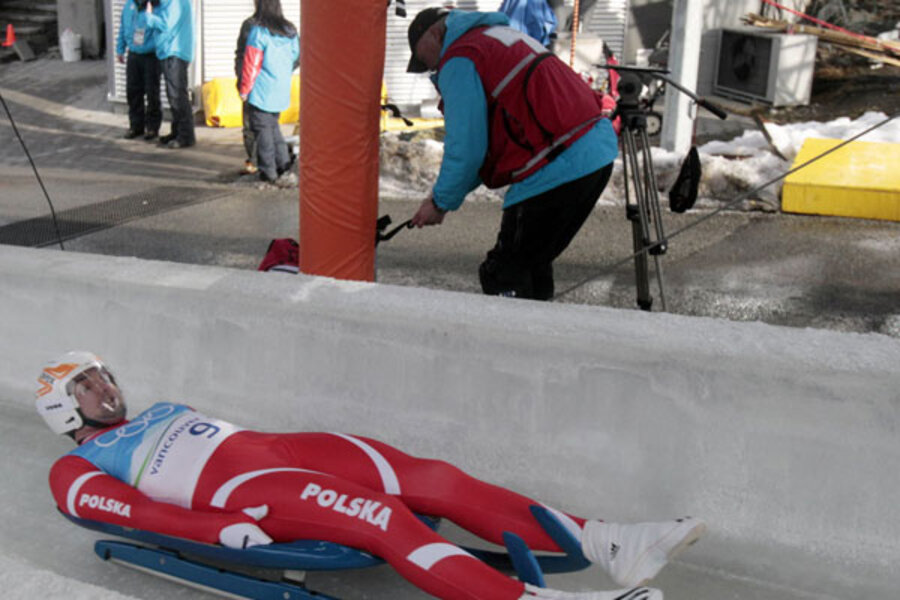Why Vancouver officials say luge track is now safe
| Whistler, British Columbia
After Nodar Kumaritashvili’s fatal crash on the Whistler luge track Friday, officials from the International Luge Federation and the Vancouver organizing committee (VANOC) this morning firmly defended their decision to proceed with the men’s luge heats as planned today. Team captains were informed in a meeting this morning and raised no concerns, the officials said.
Officials said that in addition to the precautionary measures announced overnight, they had decided that the men would race from the women’s start lower down on the track, which is likely to reduce speeds by about six miles per hour. They described the move as mainly aimed at addressing the emotional difficulty of the circumstances,
“We have to be respectful of those athletes whose friend died on that track,” said Tim Gayda, VANOC’s vice president for sport, at a press conference. “That’s why we want to make sure that they can step on [the track] with confidence and have an Olympic competition.”
The announced modifications were seen by some as a concession that the Whistler track, one of the fastest in the world, had crossed a red line from challenging to unsafe. But the officials firmly denied that, and explained the steps they had taken in deciding to proceed with the competition.
After careful review of video footage, officials traced Kumaritashvili’s path and determined that it was caused by a late entrance into curve 16, from which he was unable to recover. He was subjected to G-forces that rendered him incapable of controlling the sled, and was thus not able to avoid that crash that catapulted him out of the track, they said. Prior to the accident, Kumaritashvili had taken 16 runs on the track from the men's starting point over the past couple of years.
To guard against other athletes being thrown from the track, technicians adjusted the profile of the ice in such a way that rogue sleds would be guided back to a safer line.
Asked about why there had been no padding to cushion Kumaritashvili’s crash, Gayda said such measures would have not had a significant impact.
“Largely the objective is to keep the athlete in the track,” said Gayda. “If the athlete exits the track, hay bales or padding is not going to help the situation.”
Crash rate ratio rose
More than 30,000 runs have been made on the track by the three sports that use it: bobsled, luge, and skeleton. Out of that total number of runs, some 340 sleds had turned over, a crash ratio of 1.12 percent. (No statistics were available on the number of crashes in luge specifically.)
But the crash ratio for the 2009-10 season was higher (1.93 percent), with more than three times as many turnovers compared with last season despite having fewer runs this year. Svein Romstand, secretary-general of FIL, the International Luge Federation, said that the crash ratio was comparable with other tracks.
Tracks tend to get faster as the ice is refined and athletes get more comfortable with the course. The estimated top speed on the Whistler track was supposed to have been 137 kmh but the fastest speed recorded is 153.9 km/h – slightly higher even than the 153.0 km/h record for a 4-man bobsled on the track.
Josef Fendt, president of FIL, had in December suggested putting a speed limit on luge tracks, but he said Saturday morning that his comments had been in reference to future track. There had been talk that the 2014 Olympic track in Sochi would be even faster, and he had been warning against that, he said.
“Yes, it is one of the fastest, but we never said that it’s too fast,” he said. “That doesn’t mean that we want to have tracks in the future that are even faster, because we don’t want to push our athletes to the limits.”
Heartfelt condolences to family
While unequivocally and repeatedly maintaining that the track was safe, Fendt, Gayda, and Romstad all expressed heartfelt condolences to Kumaritashvili’s family and the Georgian delegation.
“For me personally and for the International Luge Federation, yesterday was the worst day, the saddest day in the Olympics sports and in the history of the [federation],” said Mr. Fendt, noting that it was the first fatal accident on an artificial track in 35 years. “We are all very sad and very shocked and I also personally on behalf of the International Luge Federation would like to express condolences to the family of Mr. Nodar Kumaritashvili and the Georgian delegation.”
Romstad seemed particularly affected, and reiterated the federation’s unfamiliarity in dealing with such an incident. He said all options had been considered, including calling off the Olympic luge races altogether, but the jury, technical delegates, and track management had concluded that it was safe to proceed.
Further decisions to be made
Men’s singles racers were training on the track this morning, and are scheduled to start competing at 5 p.m. tonight.
Officials are currently deciding whether to move the women’s and doubles’ starts farther down the track, possibly to the junior start, for their competitions.
The international federation for bobsled and skeleton (FIBT) will have to make its own decision about whether to make any adjustments.
_______________
You can follow Christa on Twitter. Check out our complete Olympics coverage here.





